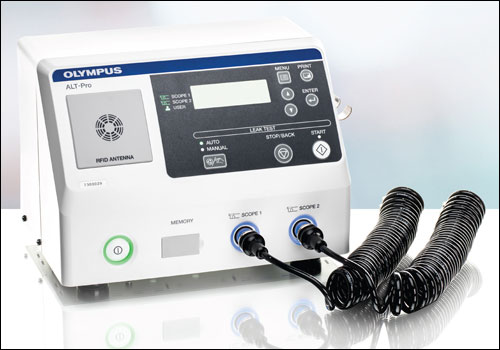A single endoscope is used on multiple patients, and must thus be cleaned and disinfected every time it is employed for medical procedures. What’s more, each endoscope must also be tested prior to every use to detect any flaws or damage. Manual testing methods, however, can be prone to human error. This month, medical and surgical procedures technology company Olympus has released its ALT-Pro endoscope leak tester, which employs radio frequency identification to help automate the device’s operation.
An endoscopy procedure consists of inserting an instrument into passageways in a patient’s body, in order to examine internal conditions. The endoscope itself is a long tube that must remain airtight. If it is functioning properly, the scope can be reused several hundred times within a year. However, after each use, the scope must be reprocessed—that is, it must be cleaned, disinfected and tested for leaks. If it develops a leak, the device must be repaired before being reused—not only because such damage could prevent the device from working effectively, but also because it could cause cross-contamination between patients. Therefore, health-care providers conduct tests to ensure that every endoscope has no leaks. Tools that detect leaks include an air pump that is used when an endoscope is submerged in water, causing the device to emit air bubbles at the site of any damage. Technicians must watch the test process very closely, to ensure they do not detect any bubbles that would indicate a leak.

Olympus has developed a dry leak-testing alternative that takes the manual process out of the equation. Instead, an endoscope is attached to the ALT-Pro, which pumps air into the scope and automatically detects the presence of any leaks. A built-in RFID reader, custom-manufactured for Olympus, captures data regarding that test. “The ALT-Pro dry endoscope leak test eliminates the need for water submersion [and] air-bubble observation,” says Russel Higgins, the associate product manager of Olympus’ Medical Systems Group. Such automation, he explains, “prevents human error, while enhancing efficiency in endoscope reprocessing.”
Each endoscope in Olympus’ Evis Exera III product line, as well as the previous Evis Exera II product line, comes with a custom-made high-frequency (HF) 13.56 MHz passive RFID tag with a model number and a unique serial number encoded on it. The tag is integrated into the endoscope’s light guide connector. A scope older than the Evis Exera II product line requires an external, pre-encoded tag that users can acquire from Olympus and attach via a strap composed of silicone rubber.
To begin the testing procedure, a technician would first wave the endoscope near the ALT-Pro’s built-in reader, which would capture that scope’s model and serial numbers. The employee would then wave his or her RFID-enabled badge in front of the reader to record who is conducting the test.
Next, the technician follows instructions displayed on the ALT-Pro’s LCD screen, including choosing between the waterless automated test and conventional water submersion. Once the worker has selected an automated test, the ALT-Pro system adjusts that endoscope’s pressurization, based on its model number captured by the RFID reader. Proper pressurization during leak testing increases the leak-detection accuracy for endoscopes of varying sizes and dimensions. The device can also record the date and time at which the leak testing occurred.
Data related to the test, including its results, can be downloaded in .CSV format to a PC via a USB connection, and can then be used for a variety of purposes. These include not only storing a record of leak tests, but also providing advanced data analysis to determine, for example, the number of times that a specific type of endoscope is tested, or quantifying a particular technician’s workload, or the number of times a given endoscope incurs a leak.
“Olympus has been thinking about the safe and effective use of RFID technology in its products for several years,” Higgins states. In 2005, the firm launched the Evis Exera II product line, which was Olympus’ first product in the United States to include a built-in RFID tag. In 2010, the company launched the OER-Pro, a reprocessor that cleans and disinfects endoscopes, and uses RFID to identify each scope, thereby sparing operators from having to manually input information about the scope’s model type. In the case of the OER-Pro, however, the RFID data is used for traceability only, and not to automatically adjust the device’s settings.
Customers responded well to the RFID functionality, Higgins reports, which saves time and reduces error risk. “We also took into account recent calls from industry societies for technology that allows for easier and more robust data tracking of the cleaning and disinfection process,” he adds. “This made investing in RFID technology for the ALT-Pro only natural.”
The ALT-Pro was made commercially available on May 1 of this year. However, Higgins notes, Olympus has been conducting a market evaluation study for the ALT-Pro since December 2013. As a result, many customers are already using the ALT-Pro with RFID functionality.

